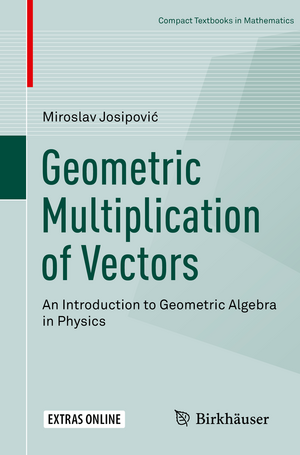Geometric Multiplication of Vectors: An Introduction to Geometric Algebra in Physics: Compact Textbooks in Mathematics
Autor Miroslav Josipovićen Limba Engleză Paperback – 3 dec 2019
Din seria Compact Textbooks in Mathematics
-
 Preț: 540.11 lei
Preț: 540.11 lei -
 Preț: 422.90 lei
Preț: 422.90 lei -
 Preț: 356.49 lei
Preț: 356.49 lei -
 Preț: 319.43 lei
Preț: 319.43 lei - 20%
 Preț: 300.32 lei
Preț: 300.32 lei -
 Preț: 421.93 lei
Preț: 421.93 lei - 20%
 Preț: 339.32 lei
Preț: 339.32 lei -
 Preț: 359.81 lei
Preț: 359.81 lei - 15%
 Preț: 494.85 lei
Preț: 494.85 lei -
 Preț: 348.39 lei
Preț: 348.39 lei -
 Preț: 585.27 lei
Preț: 585.27 lei -
 Preț: 452.83 lei
Preț: 452.83 lei -
 Preț: 350.72 lei
Preț: 350.72 lei - 15%
 Preț: 466.13 lei
Preț: 466.13 lei -
 Preț: 445.43 lei
Preț: 445.43 lei -
 Preț: 356.49 lei
Preț: 356.49 lei -
 Preț: 486.03 lei
Preț: 486.03 lei -
 Preț: 427.33 lei
Preț: 427.33 lei -
 Preț: 382.57 lei
Preț: 382.57 lei -
 Preț: 348.22 lei
Preț: 348.22 lei -
 Preț: 356.49 lei
Preț: 356.49 lei -
 Preț: 356.49 lei
Preț: 356.49 lei -
 Preț: 184.33 lei
Preț: 184.33 lei -
 Preț: 354.93 lei
Preț: 354.93 lei -
 Preț: 314.21 lei
Preț: 314.21 lei -
 Preț: 389.70 lei
Preț: 389.70 lei -
 Preț: 378.21 lei
Preț: 378.21 lei -
 Preț: 315.18 lei
Preț: 315.18 lei -
 Preț: 389.70 lei
Preț: 389.70 lei -
 Preț: 388.90 lei
Preț: 388.90 lei -
 Preț: 348.98 lei
Preț: 348.98 lei -
 Preț: 320.84 lei
Preț: 320.84 lei -
 Preț: 324.01 lei
Preț: 324.01 lei -
 Preț: 414.72 lei
Preț: 414.72 lei -
 Preț: 385.10 lei
Preț: 385.10 lei -
 Preț: 414.04 lei
Preț: 414.04 lei -
 Preț: 356.31 lei
Preț: 356.31 lei -
 Preț: 447.41 lei
Preț: 447.41 lei -
 Preț: 316.71 lei
Preț: 316.71 lei -
 Preț: 381.81 lei
Preț: 381.81 lei -
 Preț: 482.74 lei
Preț: 482.74 lei
Preț: 281.15 lei
Nou
Puncte Express: 422
Preț estimativ în valută:
53.82€ • 55.38$ • 45.37£
53.82€ • 55.38$ • 45.37£
Carte disponibilă
Livrare economică 08-22 februarie
Livrare express 25-31 ianuarie pentru 32.18 lei
Preluare comenzi: 021 569.72.76
Specificații
ISBN-13: 9783030017552
ISBN-10: 3030017559
Pagini: 234
Ilustrații: XXV, 241 p. 89 illus., 1 illus. in color.
Dimensiuni: 155 x 235 x 15 mm
Greutate: 0.39 kg
Ediția:1st ed. 2019
Editura: Springer International Publishing
Colecția Birkhäuser
Seria Compact Textbooks in Mathematics
Locul publicării:Cham, Switzerland
ISBN-10: 3030017559
Pagini: 234
Ilustrații: XXV, 241 p. 89 illus., 1 illus. in color.
Dimensiuni: 155 x 235 x 15 mm
Greutate: 0.39 kg
Ediția:1st ed. 2019
Editura: Springer International Publishing
Colecția Birkhäuser
Seria Compact Textbooks in Mathematics
Locul publicării:Cham, Switzerland
Cuprins
Basic Concepts.- Euclidean 3D Geometric Algebra.- Applications.- Geometric Algebra and Matrices.- Appendix.- Solutions for Some Problems.- Problems.- Why Geometric Algebra?.- Formulae.- Literature.- References.
Notă biografică
Miroslav Josipović is a Croatian physicist and musician with special interest in revising the language of mathematical physics and in creating new ways of teaching physics.
Textul de pe ultima copertă
This book enables the reader to discover elementary concepts of geometric algebra and its applications with lucid and direct explanations.
Why would one want to explore geometric algebra? What if there existed a universal mathematical language that allowed one: to make rotations in any dimension with simple formulas, to see spinors or the Pauli matrices and their products, to solve problems of the special theory of relativity in three-dimensional Euclidean space, to formulate quantum mechanics without the imaginary unit, to easily solve difficult problems of electromagnetism, to treat the Kepler problem with the formulas for a harmonic oscillator, to eliminate unintuitive matrices and tensors, to unite many branches of mathematical physics? What if it were possible to use that same framework to generalize the complex numbers or fractals to any dimension, to play with geometry on a computer, as well as to make calculations in robotics, ray-tracing and brain science? In addition,what if such a language provided a clear, geometric interpretation of mathematical objects, even for the imaginary unit in quantum mechanics?
Such a mathematical language exists and it is called geometric algebra. High school students have the potential to explore it, and undergraduate students can master it. The universality, the clear geometric interpretation, the power of generalizations to any dimension, the new insights into known theories, and the possibility of computer implementations make geometric algebra a thrilling field to unearth.
Why would one want to explore geometric algebra? What if there existed a universal mathematical language that allowed one: to make rotations in any dimension with simple formulas, to see spinors or the Pauli matrices and their products, to solve problems of the special theory of relativity in three-dimensional Euclidean space, to formulate quantum mechanics without the imaginary unit, to easily solve difficult problems of electromagnetism, to treat the Kepler problem with the formulas for a harmonic oscillator, to eliminate unintuitive matrices and tensors, to unite many branches of mathematical physics? What if it were possible to use that same framework to generalize the complex numbers or fractals to any dimension, to play with geometry on a computer, as well as to make calculations in robotics, ray-tracing and brain science? In addition,what if such a language provided a clear, geometric interpretation of mathematical objects, even for the imaginary unit in quantum mechanics?
Such a mathematical language exists and it is called geometric algebra. High school students have the potential to explore it, and undergraduate students can master it. The universality, the clear geometric interpretation, the power of generalizations to any dimension, the new insights into known theories, and the possibility of computer implementations make geometric algebra a thrilling field to unearth.
Caracteristici
An excellent starting point for beginners in the field An advanced high school student can learn basic concepts from the book Gradual introduction of concepts with many figures and solved examples
